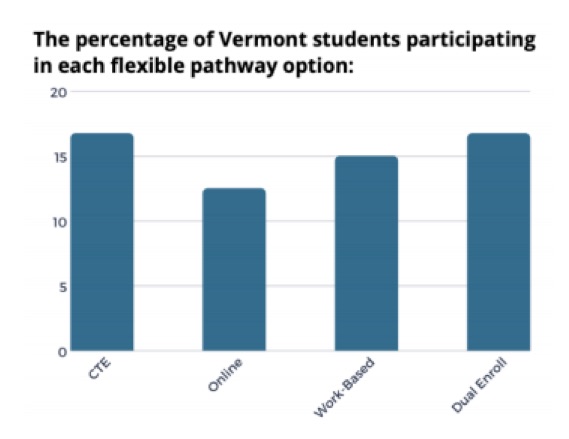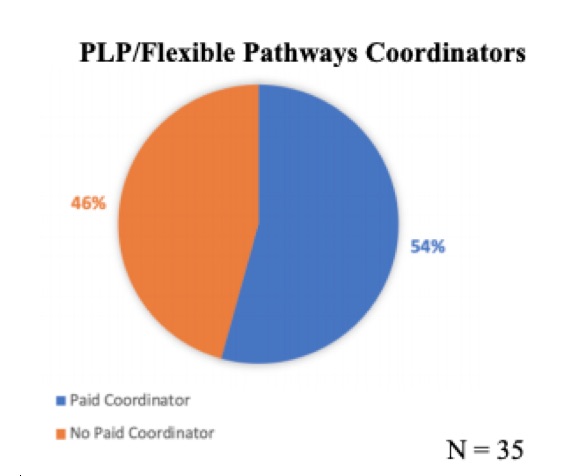Will schools really re-open this fall? And what will they look like? Most of all: how will we ensure that our teachers and students are safe?
Even though I usually do my best to think about anything but school during summer vacation, this year I’ve been tuning into the conversation on reopening.
Why?
For one simple reason: the way our schools adapt to the challenging circumstances of this fall will have enormous implications for Vermont’s students.
And the students most at risk of inadequate support during this transition, as usual, are Vermont’s most vulnerable and marginalized students.
It wasn’t so long ago that I was in high school myself.
I grew up in Jericho, VT. I graduated from Mt. Mansfield Union High School in 2015. But for the past year and a half, I’ve been researching what has become one of the go-to strategies for remote education in Vermont: personalized learning.
And what I’ve found says a lot about how schools should go about reopening.

The key ingredient: a personalized learning coordinator.
As people in the education community know, there are four main flexible pathways for personalized learning in Vermont:
- work-based learning
- online learning
- dual enrollment
- and career and technical education.
As schools explore creative ways to engage students remotely, it’s likely we’ll see an uptick in the use of these programs.
In my research, I crunched the numbers on dozens of different factors to see how they were linked to student participation in flexible pathways.
When I did, one relationship was stronger than all the others, separating schools with robust flexible pathway programs from those with weak programs. It was almost too obvious.
What was the magic ingredient? A coordinator.
Schools that had a personalized learning coordinator on staff tended to have higher rates of student participation in their flexible pathway programs.
Without diving too deep into the methodology, it’s worth explaining where that result comes from.
In the fall of 2019, I sent out a survey to all principals of Vermont public high schools asking about their personalized learning and flexible pathways programs. I asked for all sorts of details: professional development priorities, advisory programs, student leadership, parental engagement, and more.
35 out of 60 principals – 58.3% – provided data. And the numbers told a story.

Without any fancy statistical methods, I could estimate the rates at which students across the state were actually participating in flexible pathways. I could see how many schools had a devoted personalized learning coordinator.
But actually crunching those numbers revealed results that were even more telling.

When I regressed flexible pathway participation rates on each school-level factor, I found there was a statistically significant positive relationship between the presence of a pathways coordinator and student participation in flexible pathway programs. Even when controlling for school size and student poverty rate.
(There were other findings too, but – shameless plug, again – you can find more specific data in my paper (.pdf))
How big was the effect?
Having a pathways coordinator on staff was associated with an increase in overall flexible pathway participation of five to fifteen percentage points.
When I interviewed some of those coordinators, the reasons for this bump in participation became clear.
Flexible pathways can help students learn in new and engaging ways. For example, at the workplace through an internship placement. Or about a new topic – say marine biology – through an online course.
But these opportunities can be difficult for students to set up on their own. And without a coordinator to help them select the right options and then navigate the registration process, many students miss out entirely. Especially for students who don’t have parents actively involved in their education, flexible pathway options can become inaccessible.
Take dual enrollment, for example.
Dual enrollment allows Vermont students to take college courses while still in high school, giving students a taste of college-level content and allowing them to get a few credits under their belt before enrolling in college. The policy was intended to make higher education more accessible to first-generation students. Has it followed through on that goal?
Not exactly.
Because there are so many hoops students have to jump through to register for dual enrollment, the programs have mostly become populated by well-resourced students. “Dual enrollment is for your high-flyers,” April Wortmann, a coordinator from Mt. Abraham Middle High School, explained to me. “It kind of did the inverse of the intent.”
Similar issues crop up with online learning.
Without a coordinator, how will students find and enroll in the course that’s right for them? Or work-based learning. How will students set up an internship placement all on their own?
Again and again, I found that when students are left without a coordinator to guide them, flexible pathway programs tended to create starker divides between the “haves” and the “have nots.”
So how, you may ask, does all this play into school reopenings?
Coordinators as a COVID learning solution
As our schools experiment with hybrid and remote learning models, it’s likely that they will rely more and more heavily on flexible pathway options to engage students outside the classroom. But at the same time, many schools are facing tightened budgets, and many “non-essential” staff positions may be on the chopping block.
If my research has anything to say about how schools should go forward, it’s that personalized learning coordinator roles need, need, NEED to stay.
And schools that don’t yet have these roles must create them.
Perhaps the best way to prove my point is to explain what pathways coordinators actually do.
In early March, just before COVID shut down life as we know it, I spoke with Terry Berger, Multiple Pathways Coordinator at Leland and Gray Union Middle & High School, about her role.
She recounted a number of key responsibilities that she shoulders. Of course, these roles were pre-COVID, but many responsibilities carry over.
The following is an incomplete list:
Berger advises students on how to navigate her school’s pathway options, she runs the school’s work-based learning program and teaches the program’s classroom component. She finds internship placements for students and coordinates their transportation (sometimes driving students herself). She publicizes dual enrollment and online learning options, and manages the labyrinth of paperwork for students who register. Plus, she guides students through technical glitches in their online courses in the evening via text messaging.
Berger’s two specialties, work-based learning and online learning, may be some of Vermont’s best options in keeping students engaged this coming year while minimizing their time in the classroom.
But it’s not easy.
Any one of these responsibilities, alone, could be a headache. Together, they are hero’s work.
“Sometimes it really does feel that there’s just not enough time in the day,” said Berger.
At the beginning of each semester, Berger matches the 20+ work-based learning students to local internship opportunities. It’s a web of emails, applications, meetings, phone calls, safety checks, background checks, and more. “I don’t eat or sleep or spend time with my children for a solid four weeks,” said Berger. “It’s just absolute mayhem.”
Try pulling off an effective work-based learning program without someone like Berger. The chances of success are slim. Before her role was created, Leland and Gray’s work-based learning program was more of a “dumping ground” for students who had abandoned the college track, she recalled.
In Berger’s short tenure at Leland and Gray, the composition of the program has changed completely. Describing her students, Berger said, “They’re college-bound, they’re trades bound, and there are opportunities for all of those kids. It’s not just the kids who don’t do well in school.”
For maintaining equity in personalized learning programs, coordinators like Berger are essential.
The right fit for the job
A number of factors seem to determine who makes an effective pathways coordinator.
For one, connections in the community.
Berger believes that her status as a local boosts her effectiveness as a coordinator. “I know everybody,” said Berger. “That for me has just been the key.” And though it’s not her go-to technique, she admits that she has landed internship placements for students while in line at the deli or the hardware store.
Another key? Flexibility of schedule.
Like Berger, Patty Davenport, Pathways Coordinator at the neighboring Springfield High School, often works in the evenings to better support her students. Usually it’s after school that students are logging on to dual enrollment and online learning courses. She makes sure to be available in the case of any glitches.
Going forward there’s good news and bad news.
The good news? Vermont schools have the capacity to support all students as they navigate personalized learning opportunities, regardless of socio-economic status. Many of the coordinators I spoke to had already found innovative ways to do so.
The bad news? These schools are the exception not the rule. Many Vermont schools do not yet have flexible pathway coordinator positions, and as they figure out what this coming year will look like, they have some catching up to do if they seek to make personalized learning accessible to all students.
In the age of COVID, this change is urgent.
Should out of school internships be available only to students who know where to look? Should project-based learning be a reward to students already who have the supports in place to work independently? And should online dual enrollment courses be restricted to those students who know how to navigate the college registration systems and the classroom norms?
Think about students with unreliable internet access. Think about students without a quiet room to in which work. These are the students who have been historically underserved by our schools. They are disproportionately low-income. And they are disproportionately first-generation college hopefuls.
They need someone in their corner. They need someone like Terry Berger.
So yes, even if it means thinking about academics during summer vacation, I do care about how schools are reopening this year. Specifically, I want to see them reopen with flexible pathway coordinators ready to lift up the students hardest hit by the pandemic.


